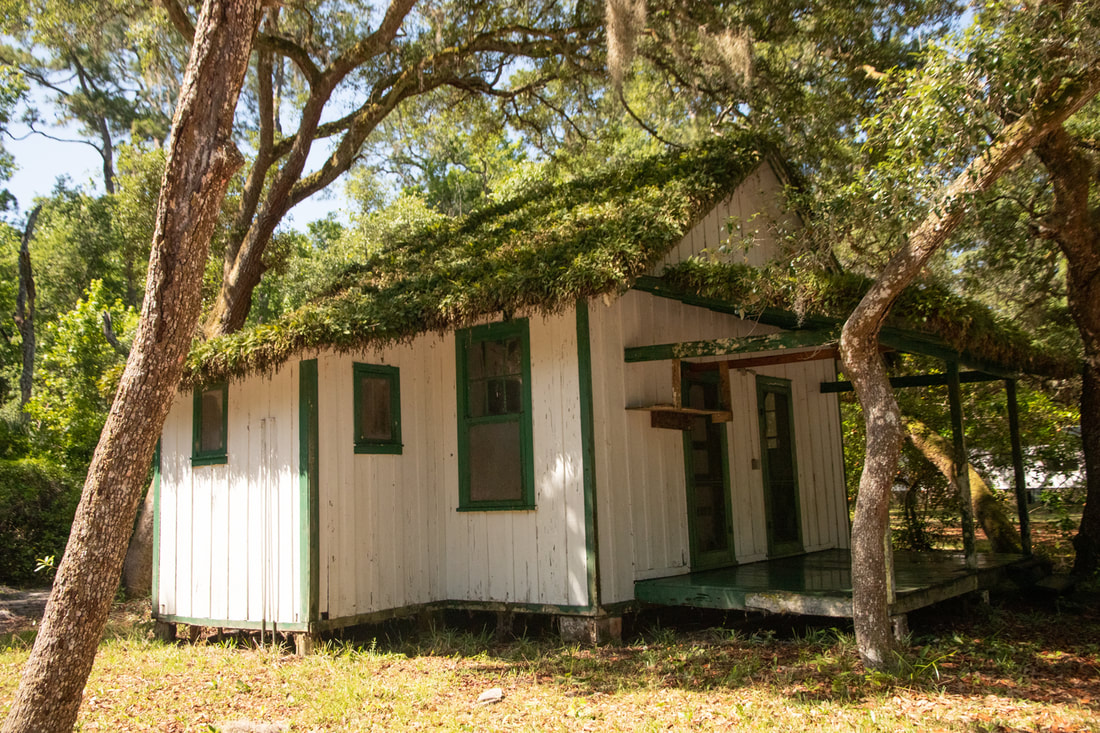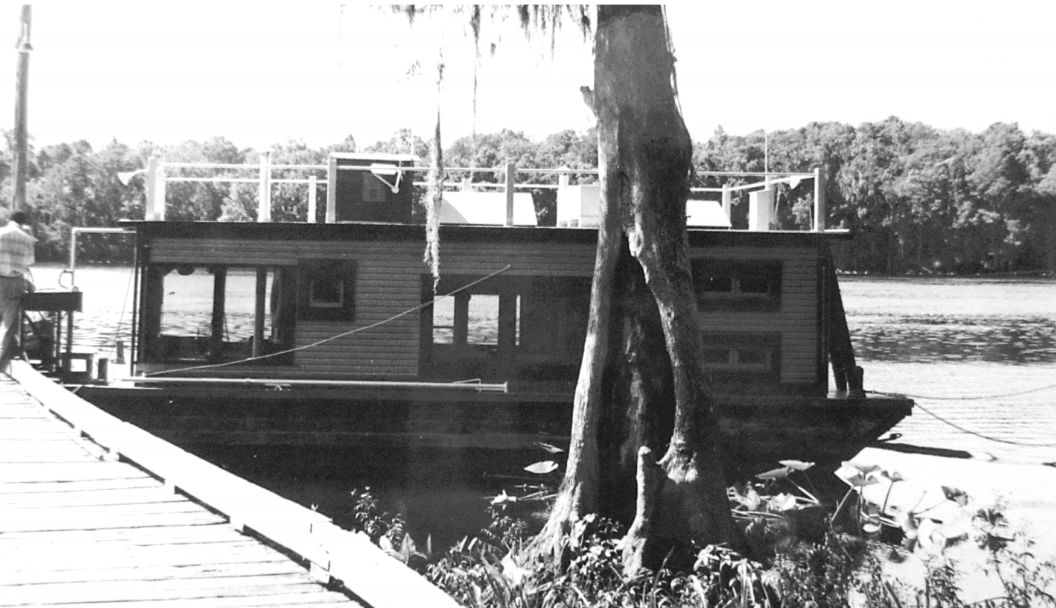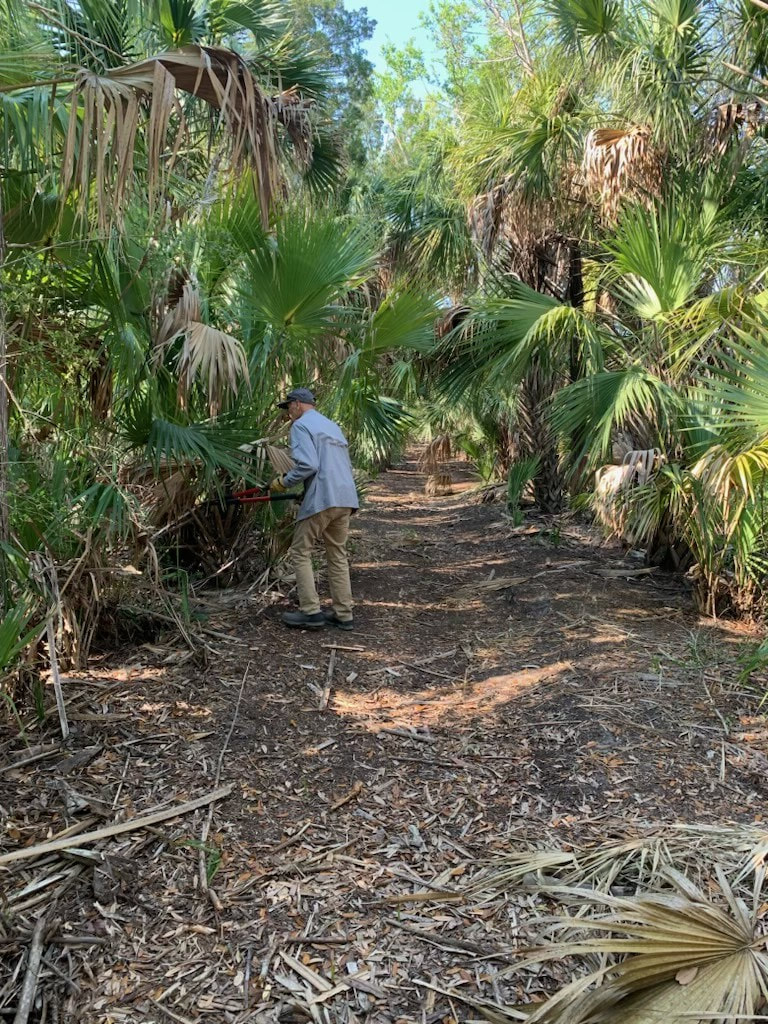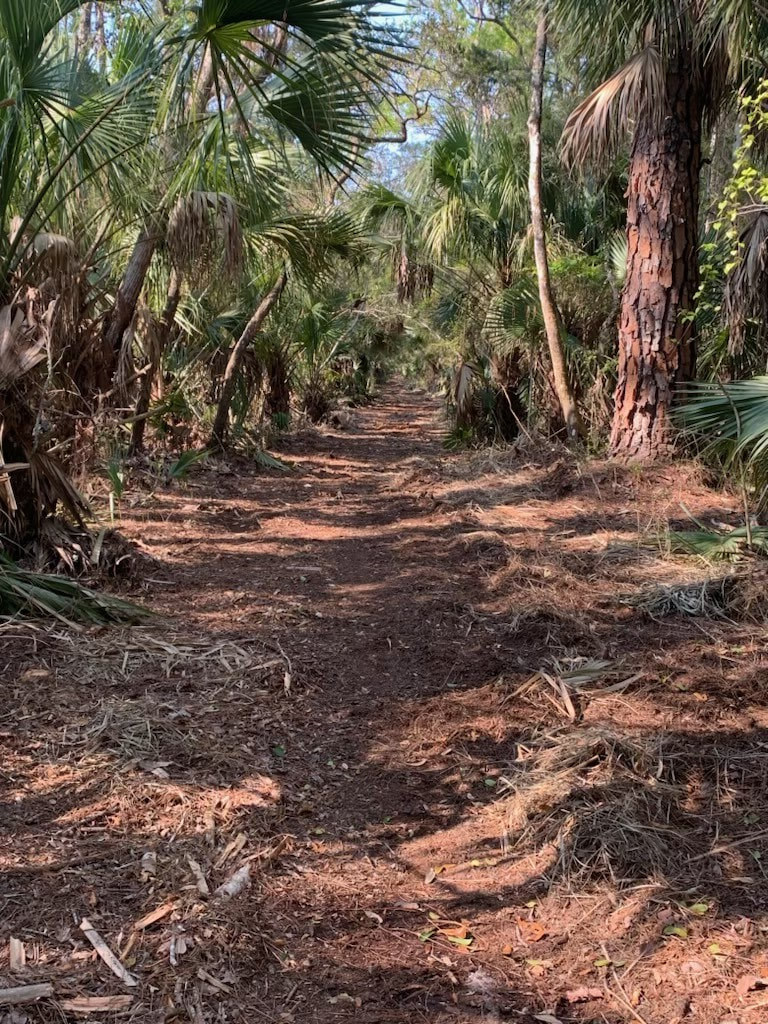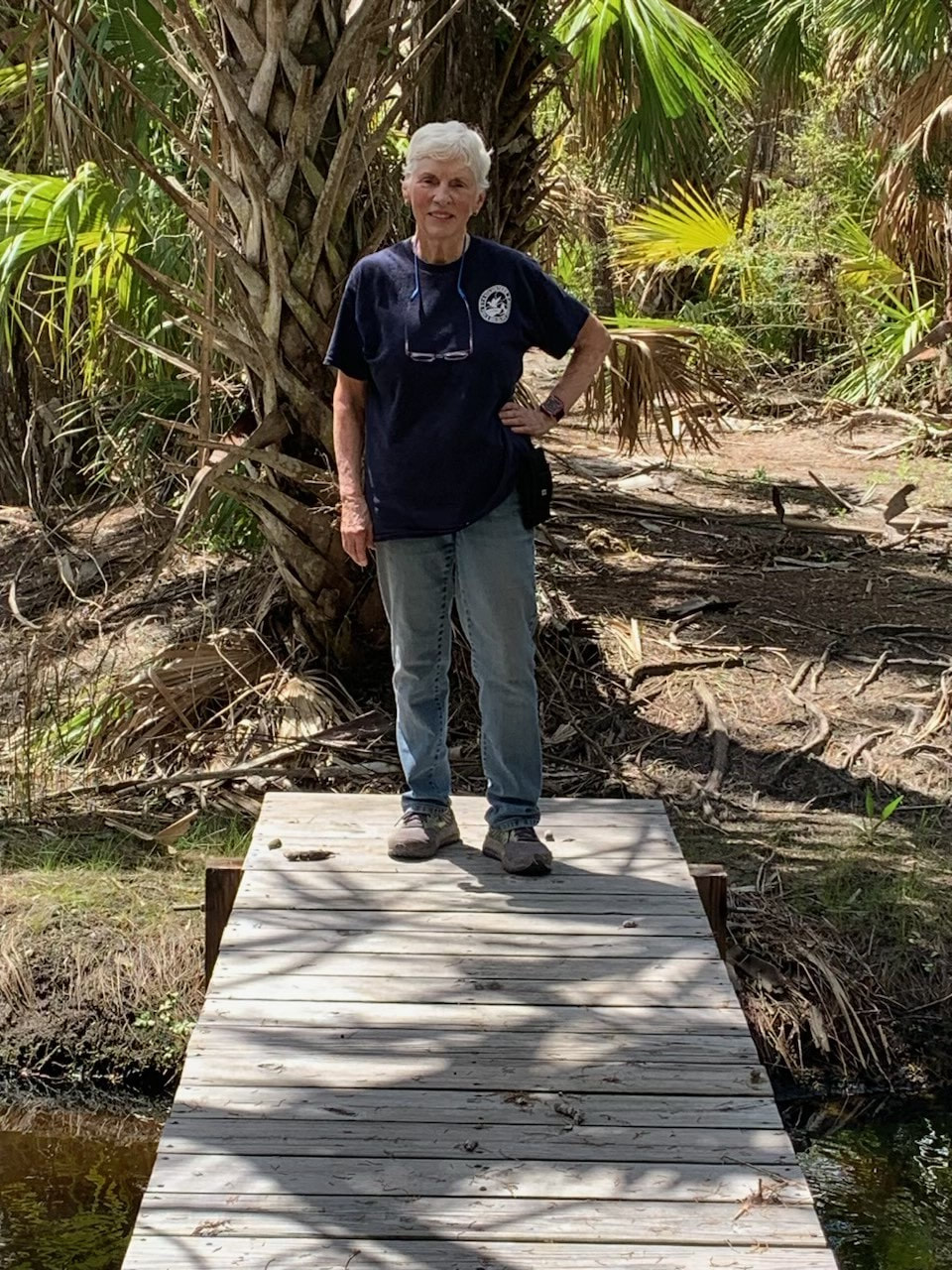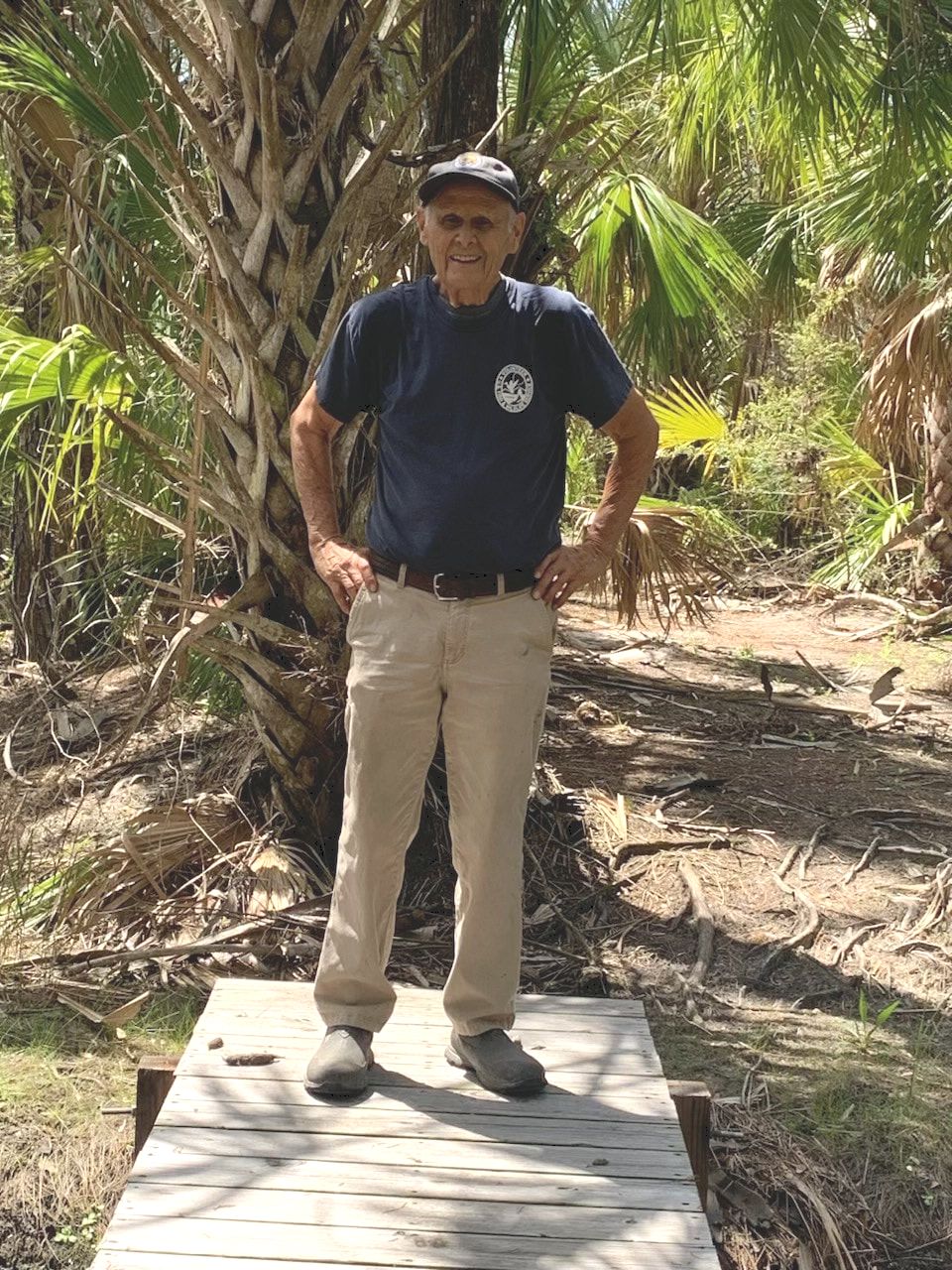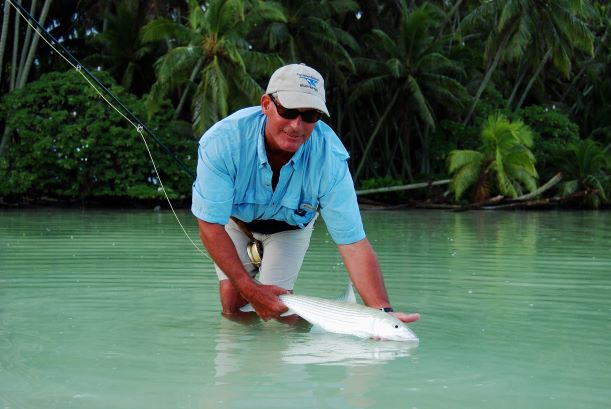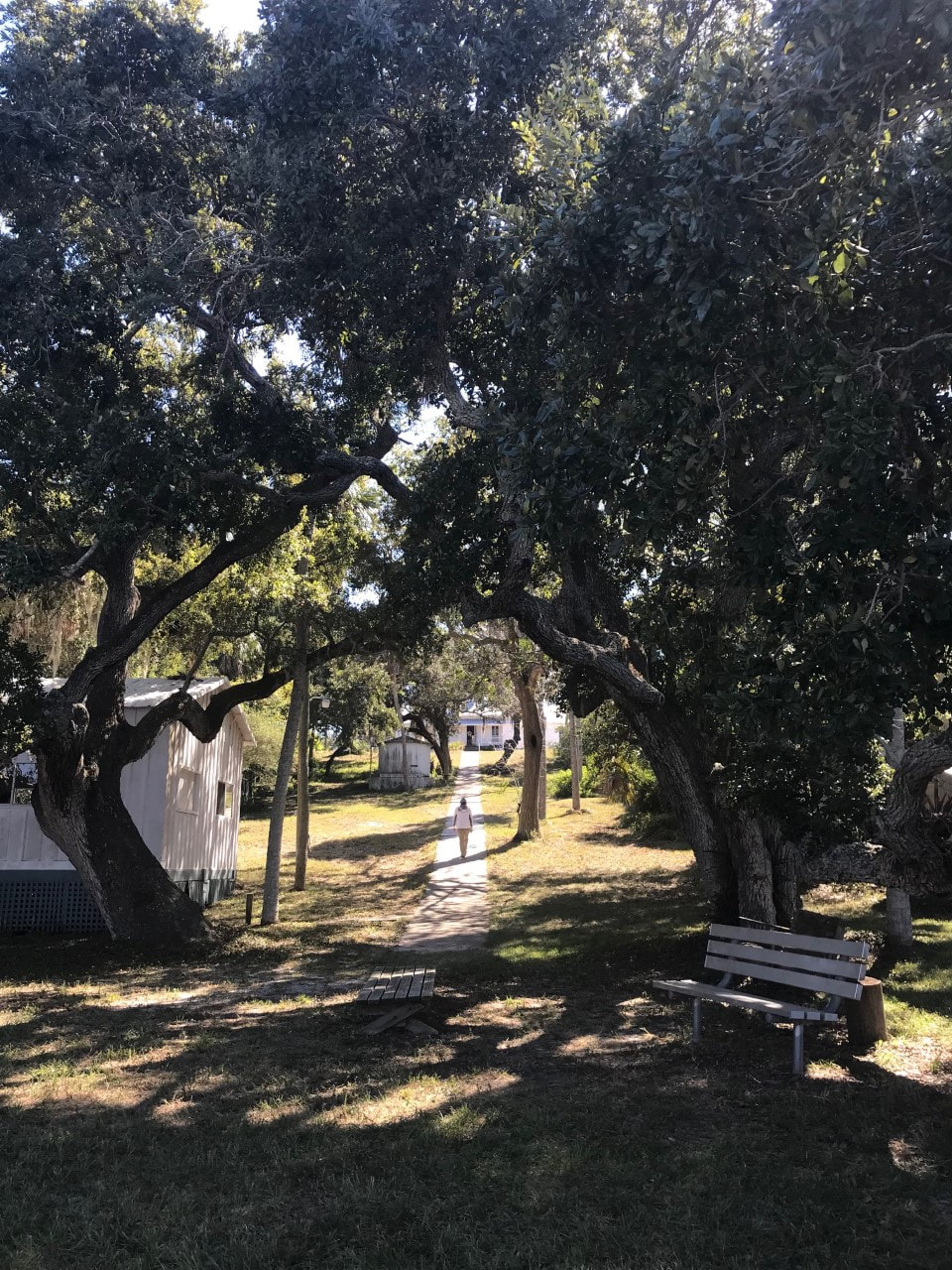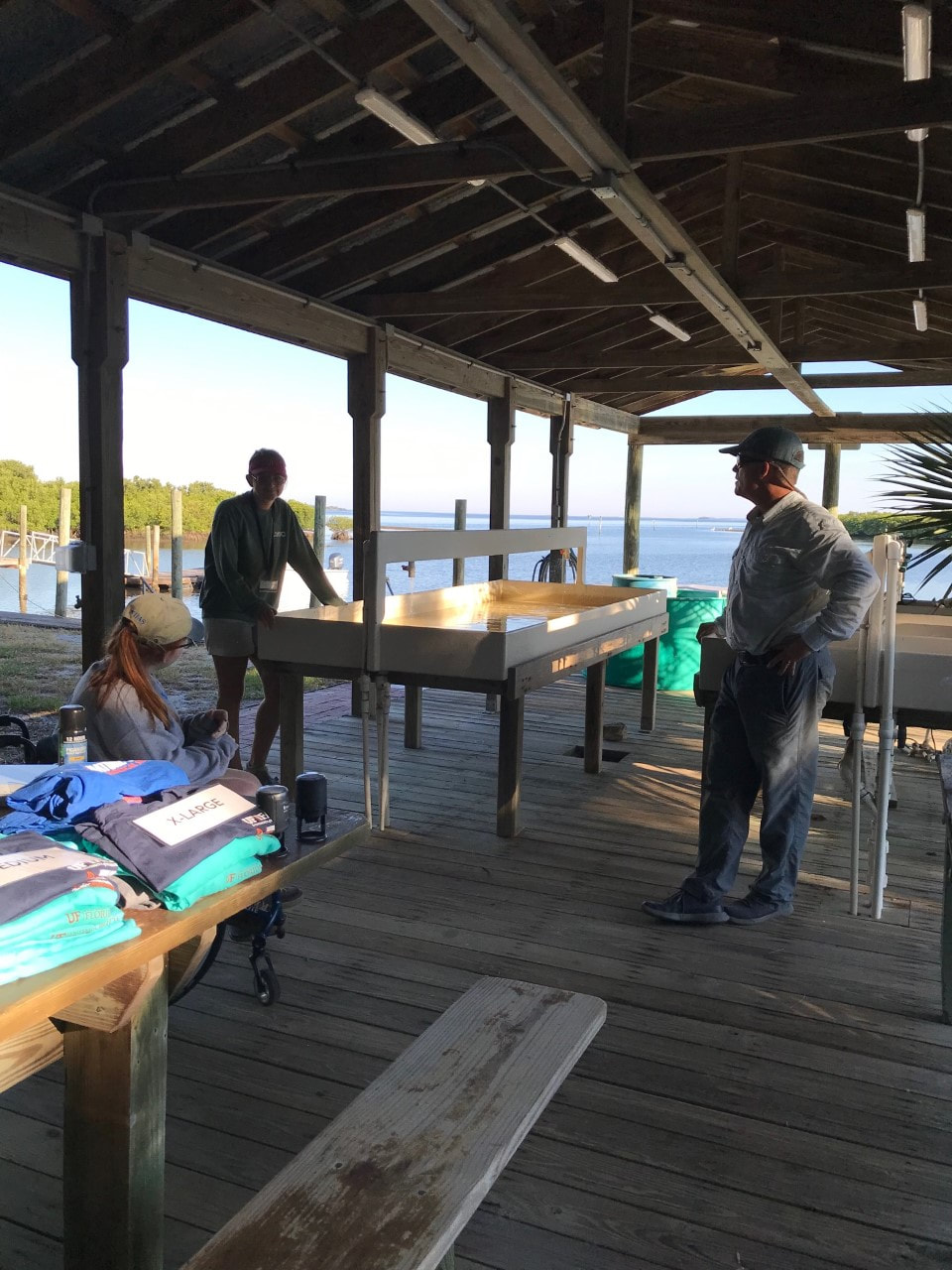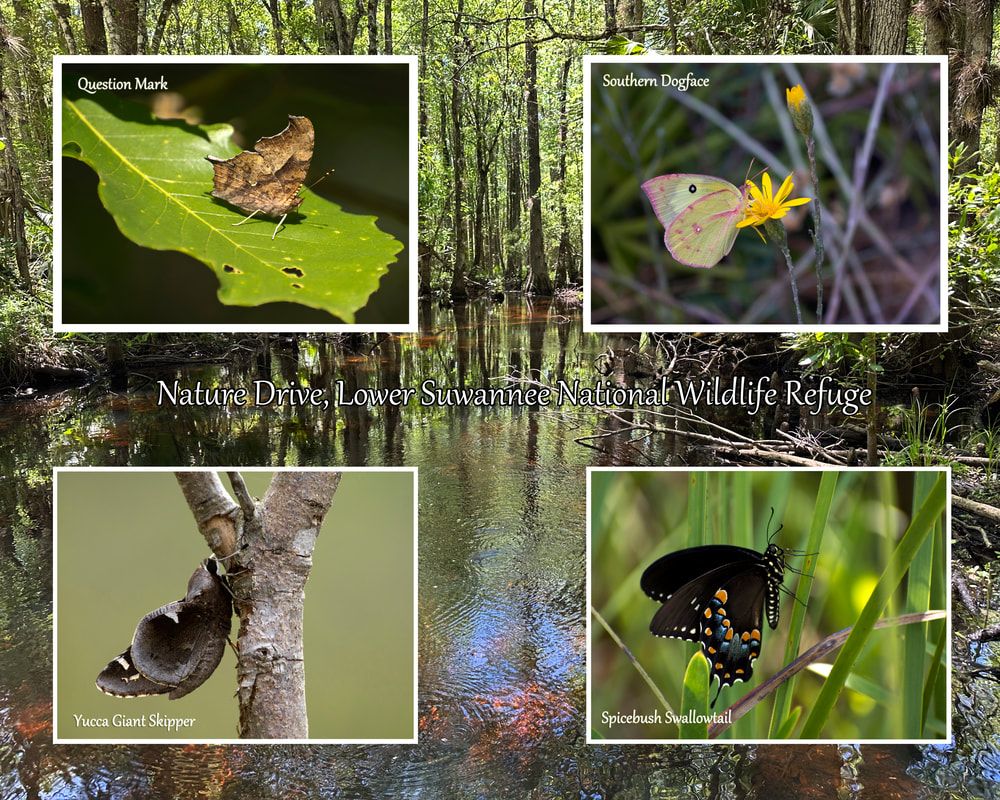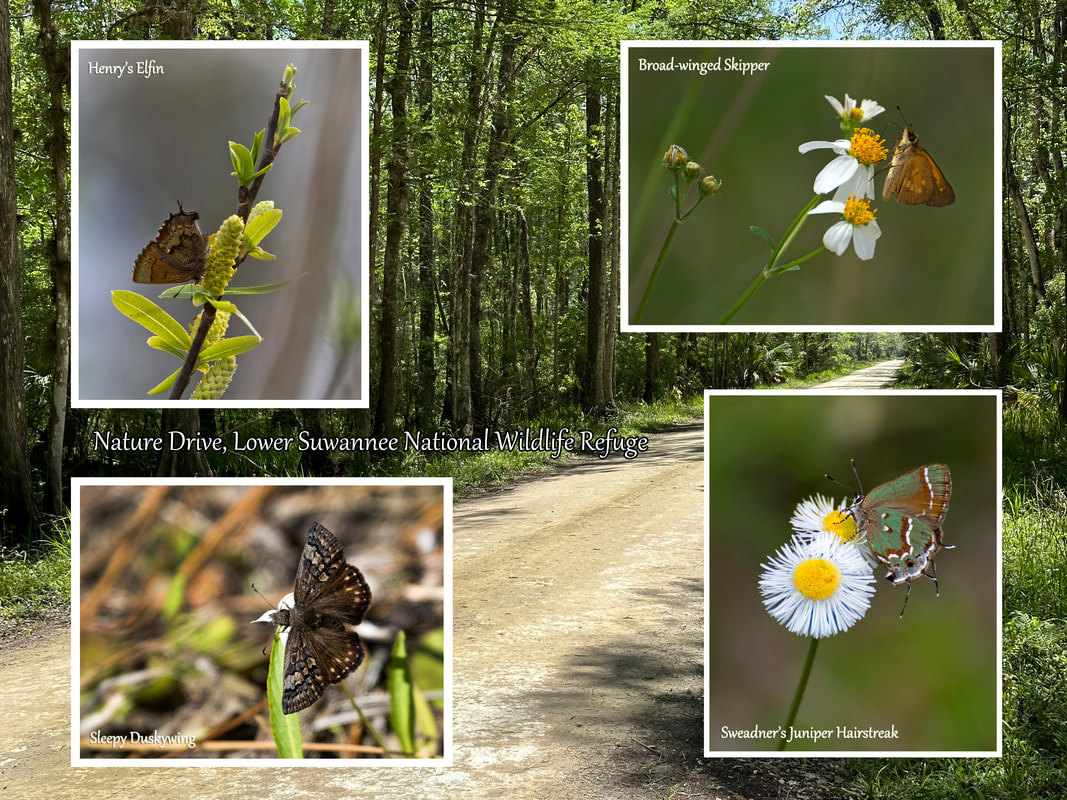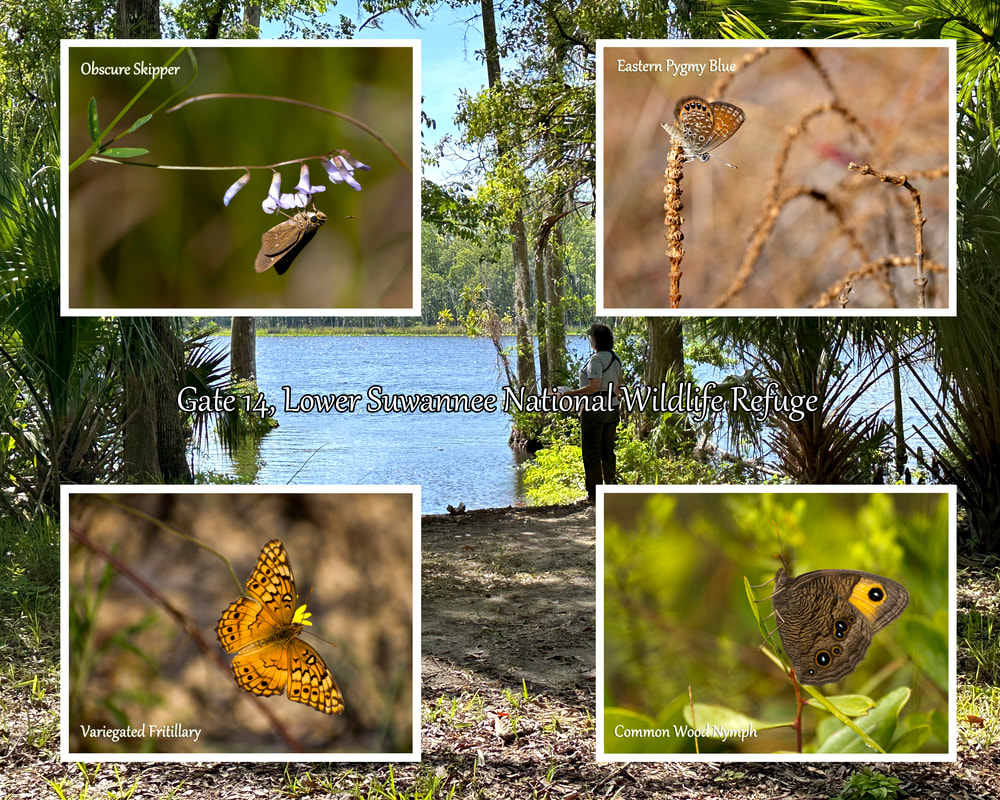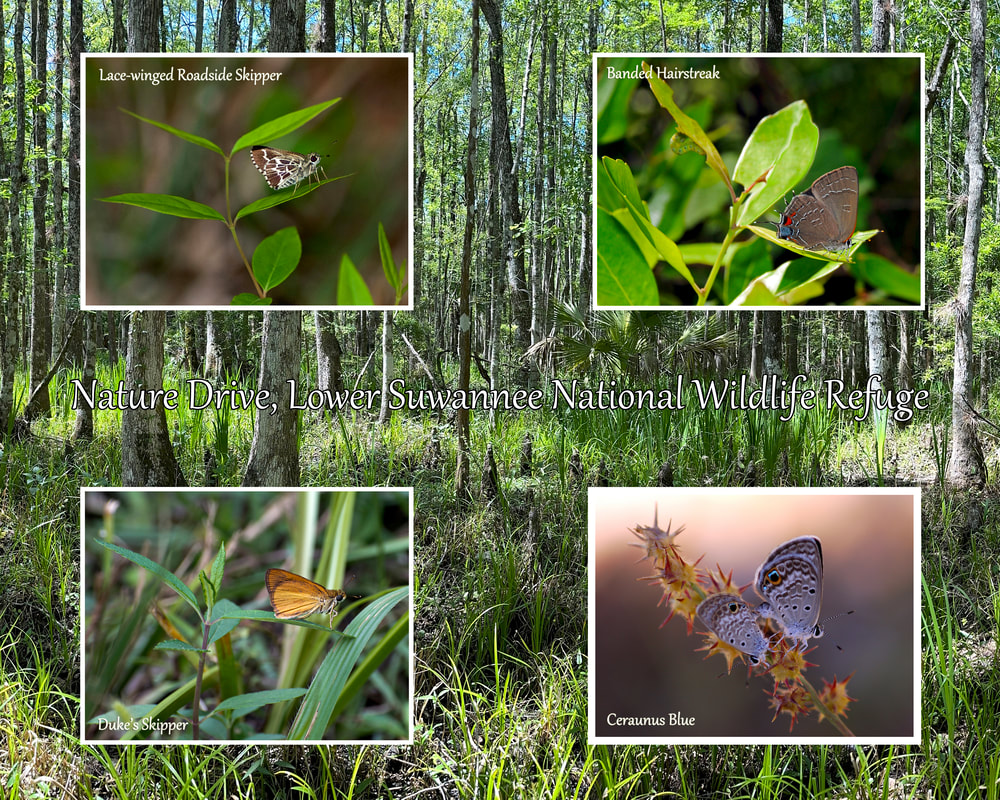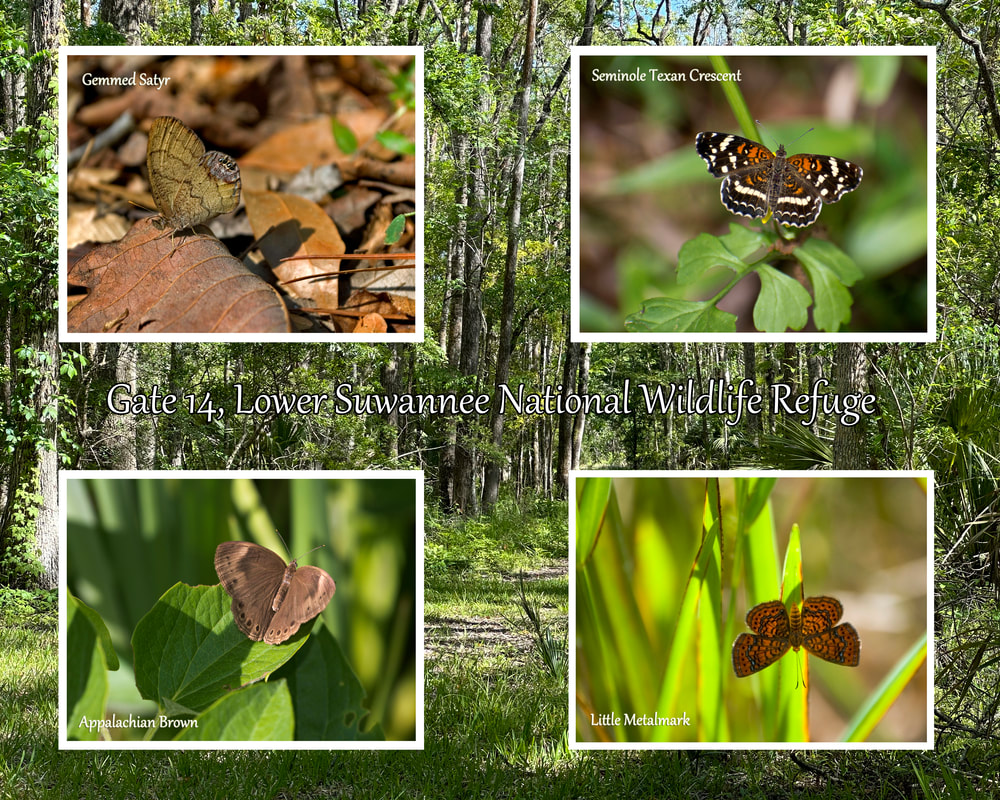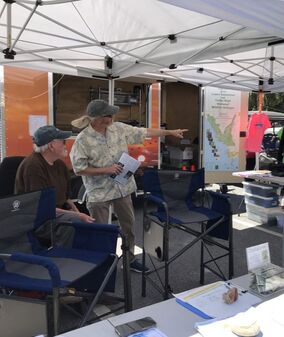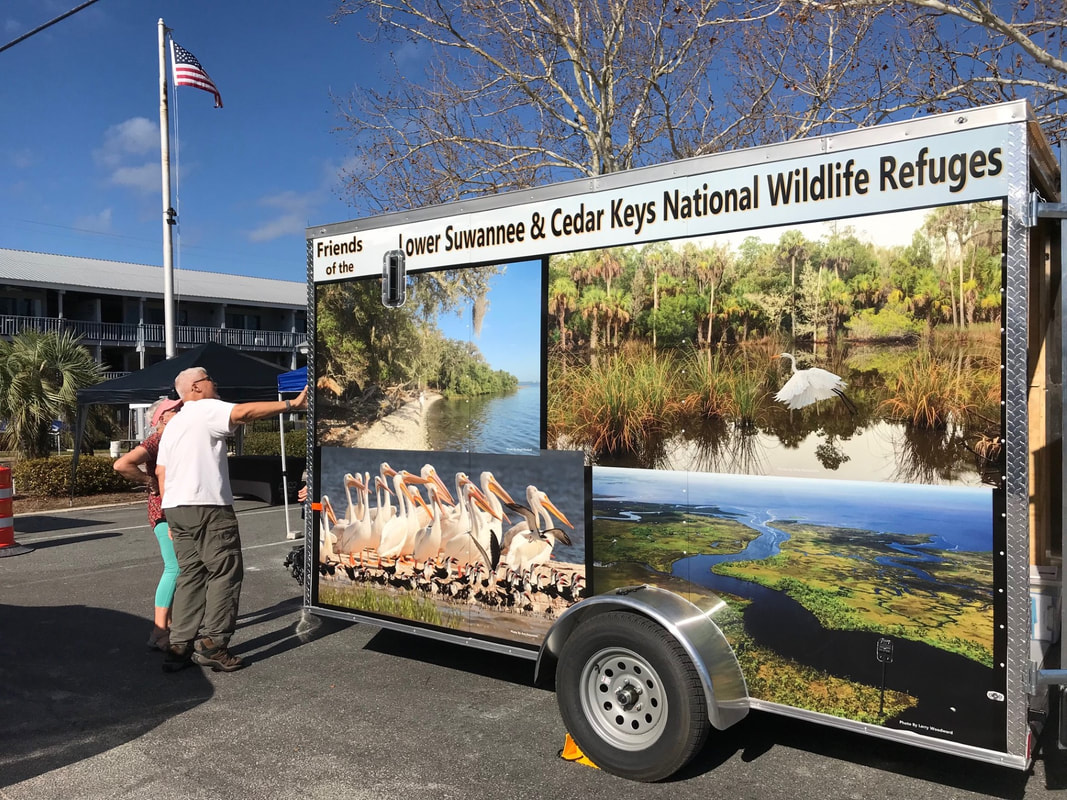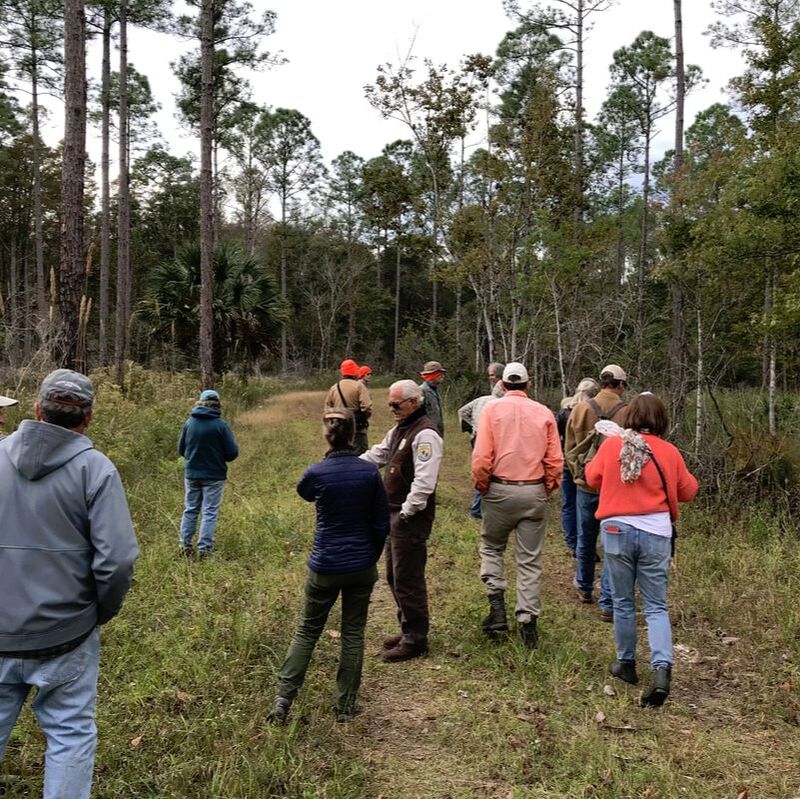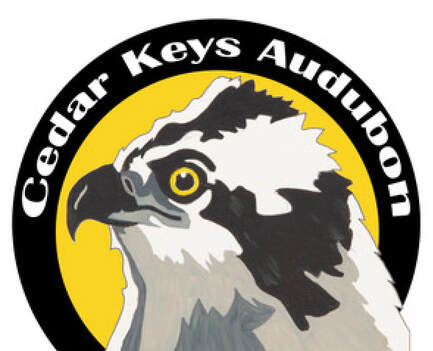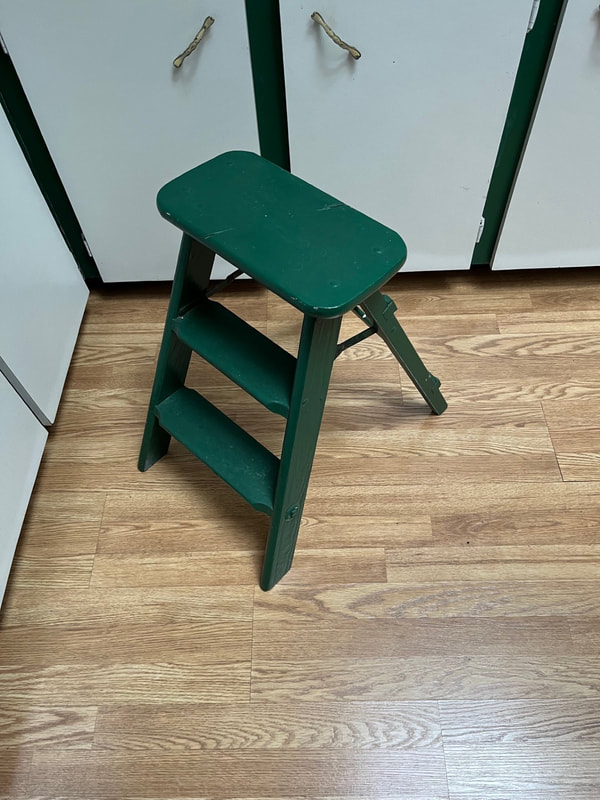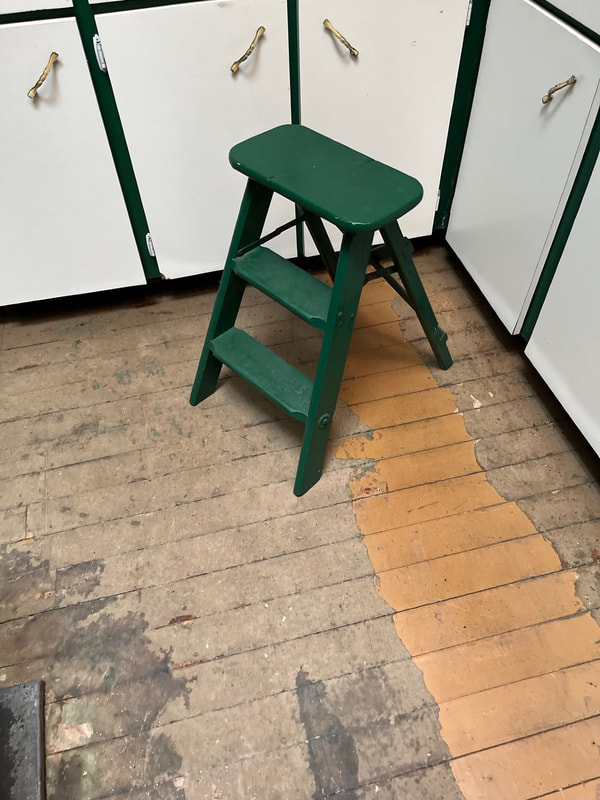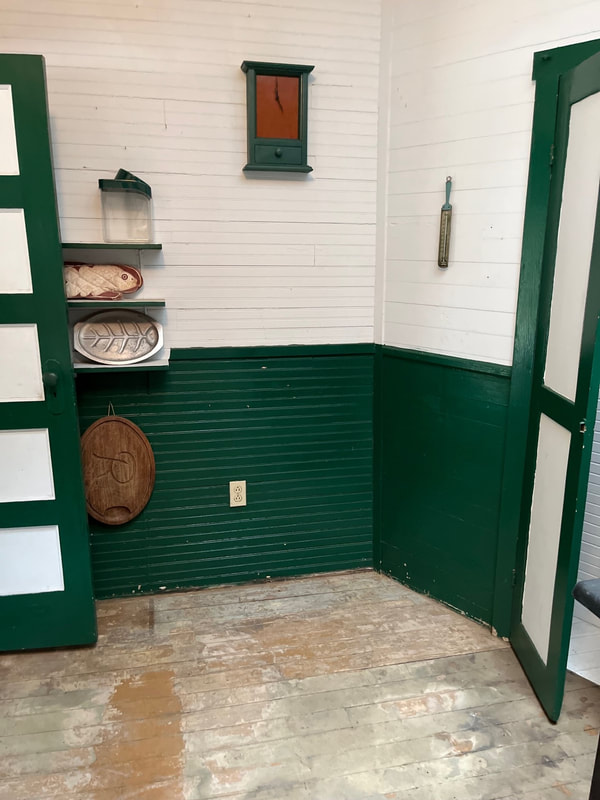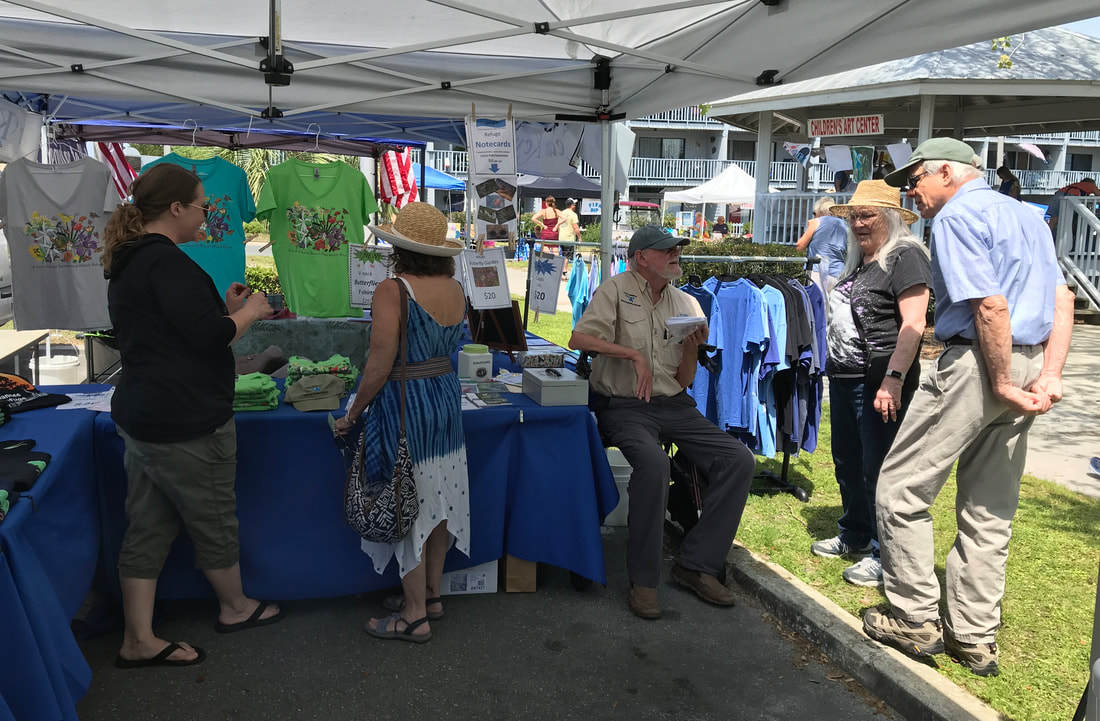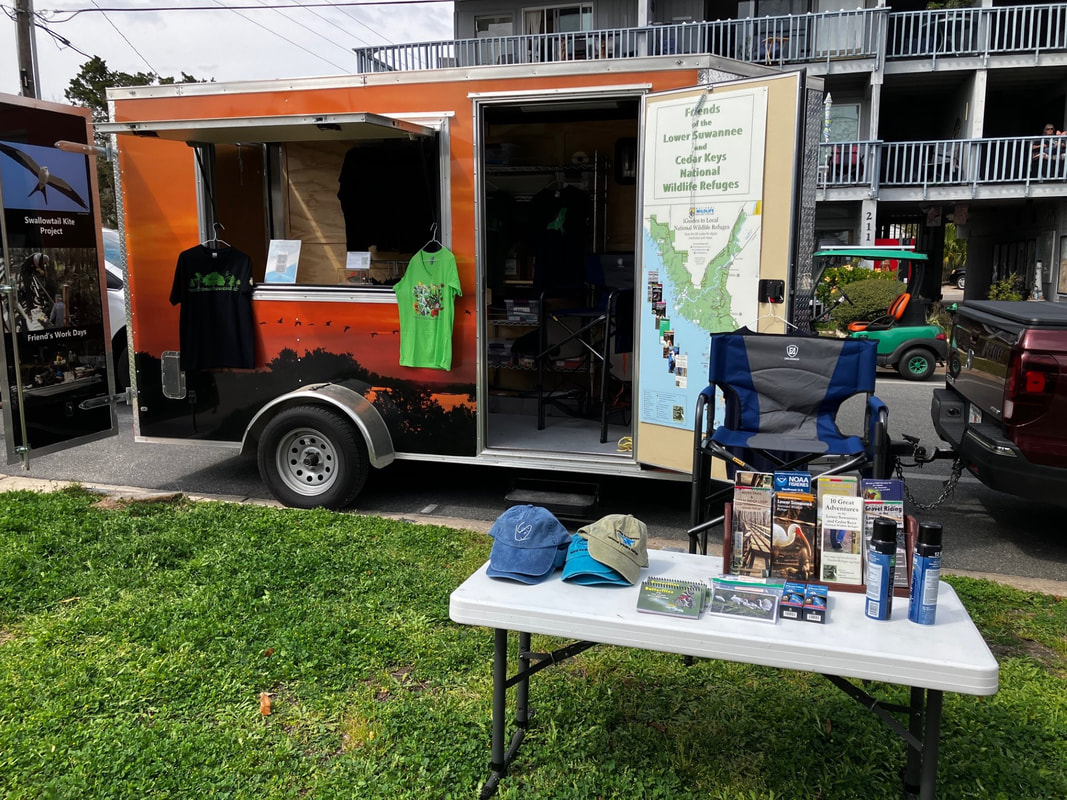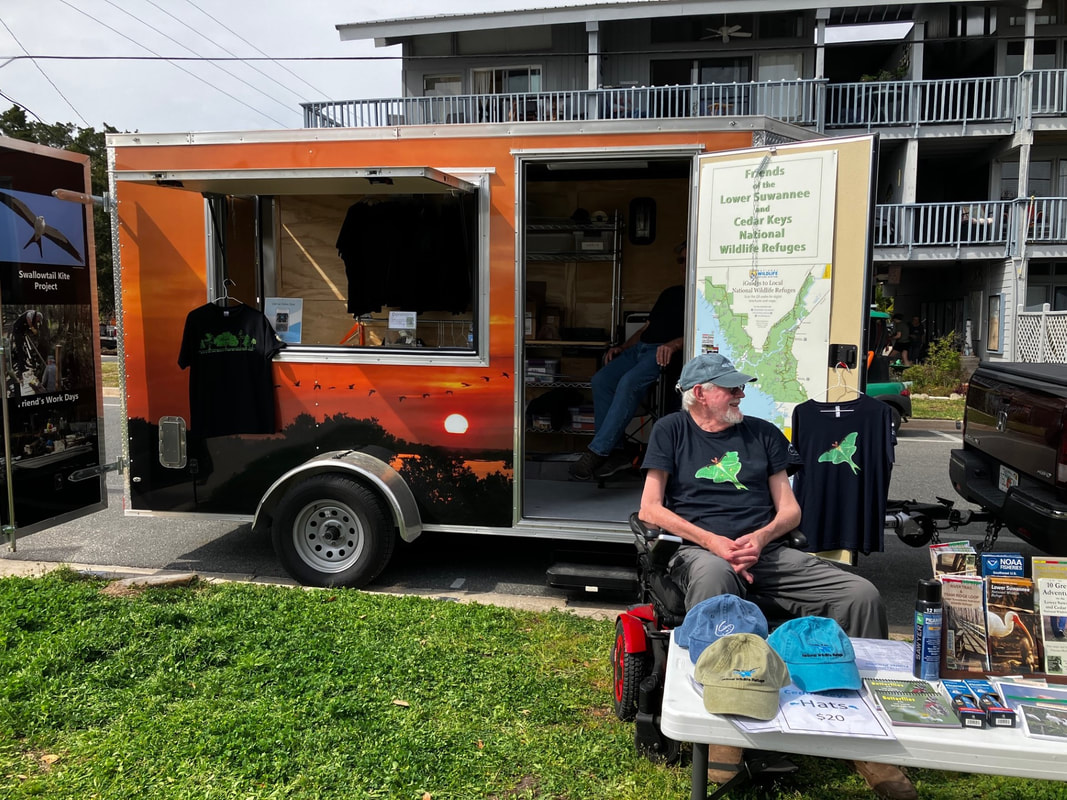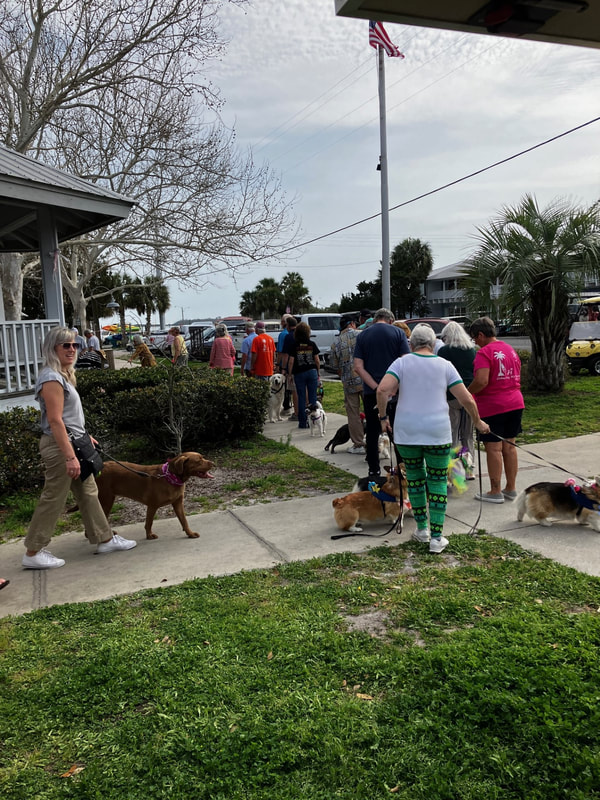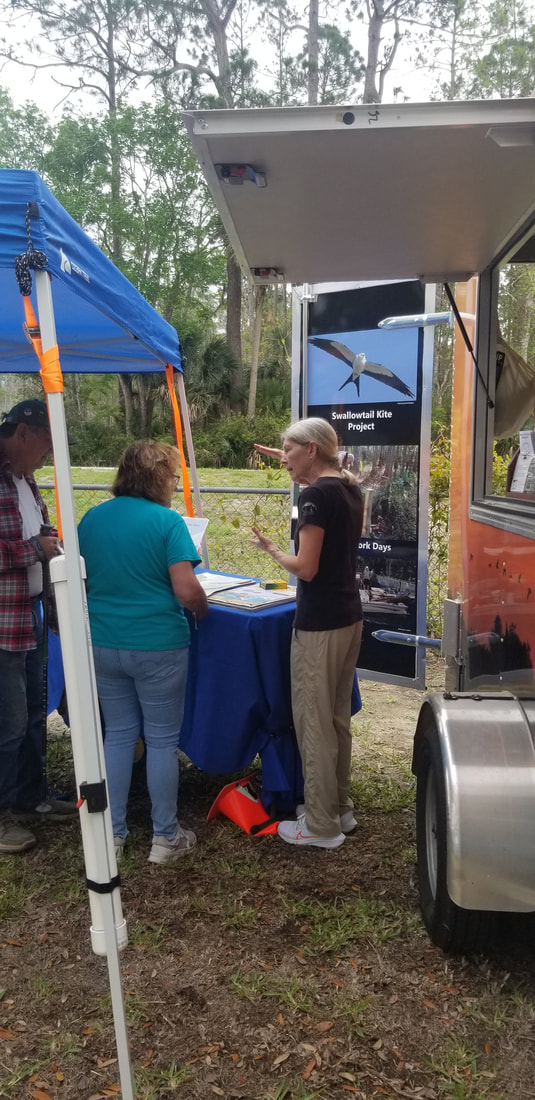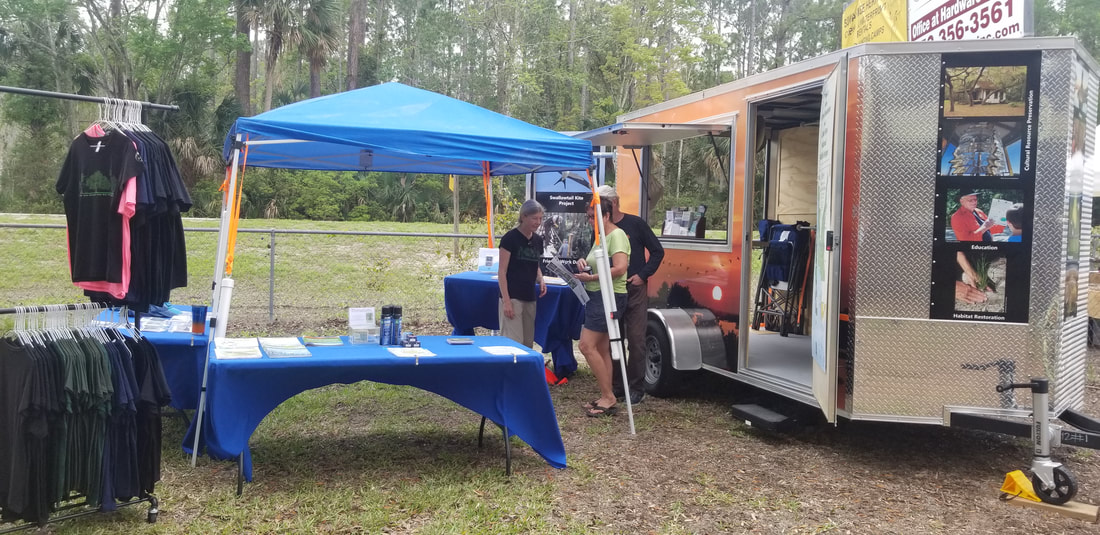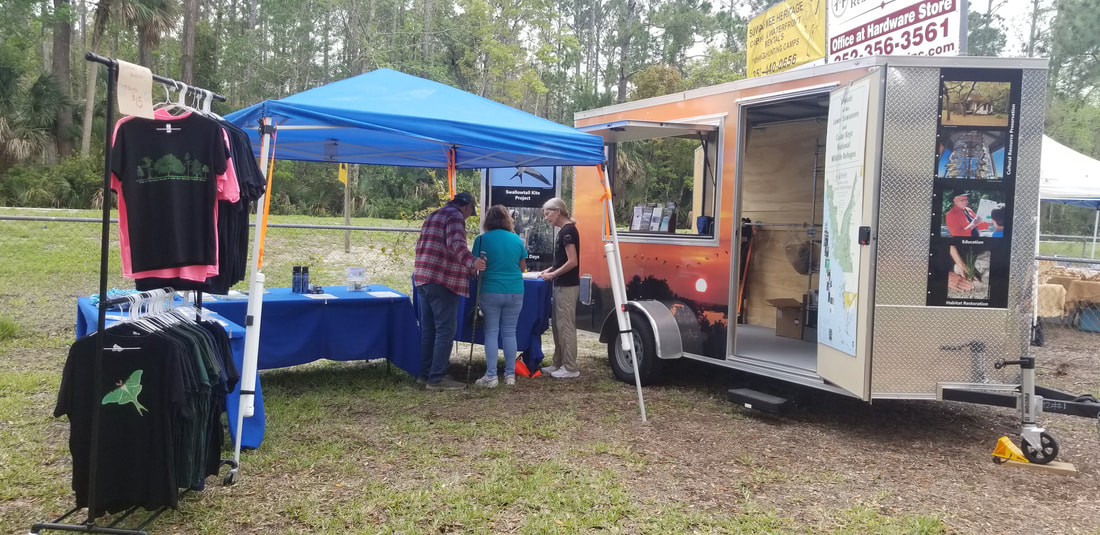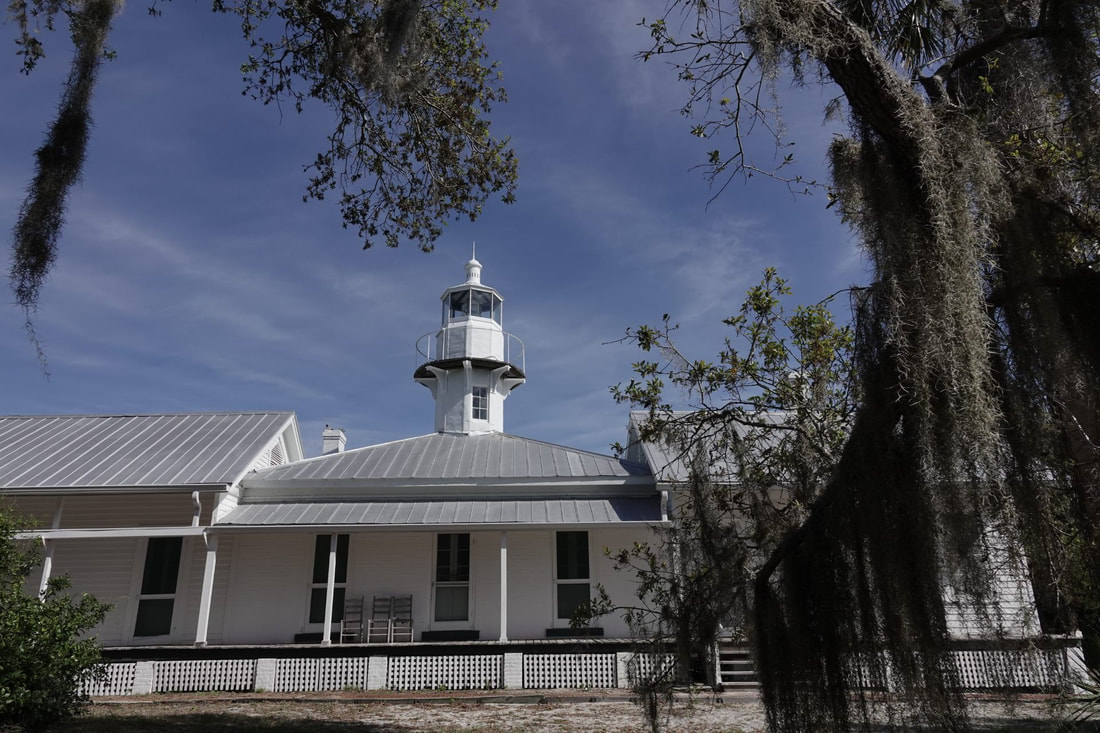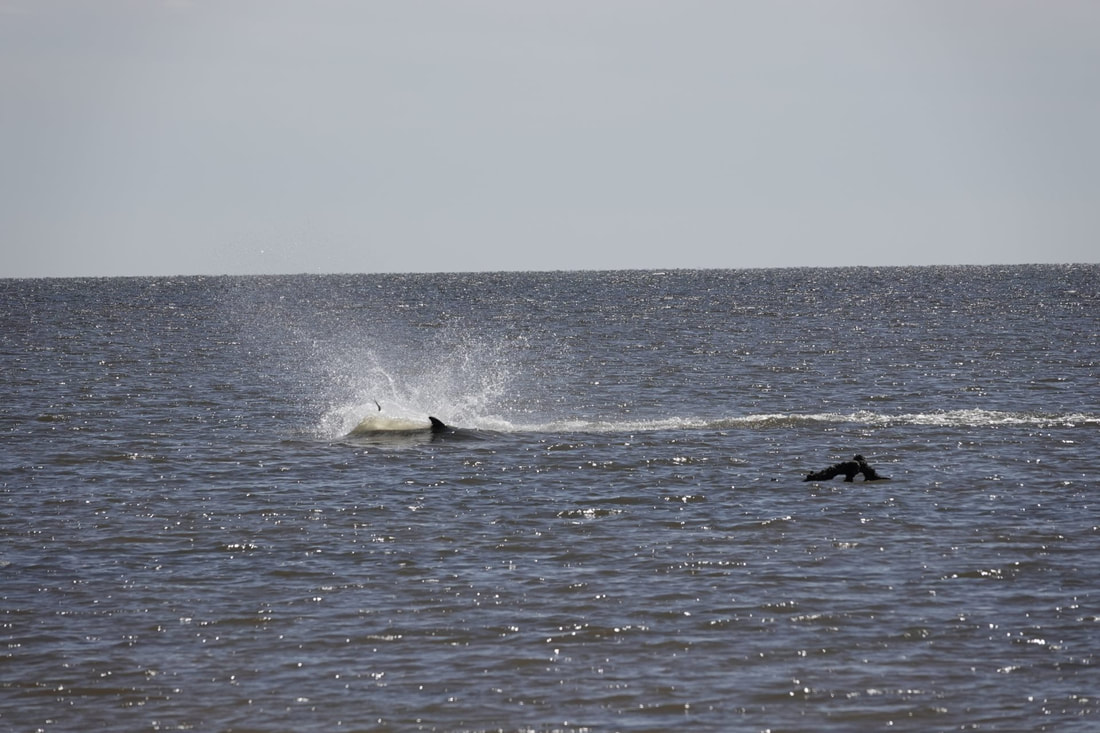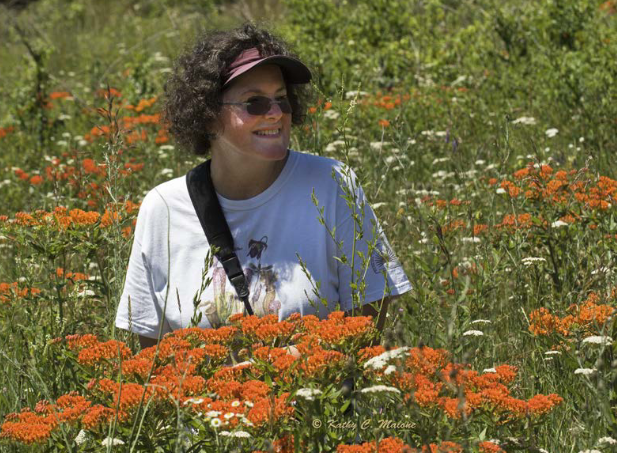|
We all know that Shell Mound is a special place and during Friends solstice celebrations our archaeologist friends delight us with stories about past cultures that really make it sing.  More than 50 people came out on a hot but otherwise perfect day to learn about the Mound. Friends' Immediate Past-President Dr. Ginessa Mahar animatedly guided 25 enrapt guests along the Shell Mound trail. She tied past celebrations together with our activities today. A spectacular talk!  Dr. Ken Sassaman's talk. Photo by Dorsey DeMaster Dr. Ken Sassaman's talk. Photo by Dorsey DeMaster Next, Dr. Ken Sassaman described techniques archaeologists used to learn from remnants and discards at Shell Mound. He spoke about the shape of Shell Mound and similarly shaped possible habitations on nearby islands that were all abandoned around the same time.  Nigel Rudolf at Hog Island. Photo by Debbie Meeks Nigel Rudolf at Hog Island. Photo by Debbie Meeks An archaeo-kayak tour, led by Nigel Rudolph of the Florida Public Archaeology Network, visited other archaeology sites near Shell Mound including Komar. Along the way, paddlers learned about cultural differences and efforts to repatriate items in museum collections. Dorsey DeMaster, Florida Paddling Trails Association's regional co-director for our area, told paddlers about the Florida Circumnavigation Trail (CT) that routes paddlers along established water trails and camp sites. Native people probably used similar routes on their journey to solstice events at Shell Mound. If you missed this Summer Solstice celebration at Shell Mound, watch for announcements of our Winter Solstice celebration and come join Friends at Shell Mound in December.
1 Comment
Take advantage of a rare opportunity to own a piece of history. Friends grant from the Florida Division of Historic Resources, supporting the effort to make the Cook's House at Vista weather tight is now on the fast track. Work on stabilizing the foundation may begin as early as Saturday, June 1st. Once the foundation work is complete, contractors will be replacing the roof. The current roof is covered with spectacular resurrection fern. While it is not possible to save the Cook's House fern roof, it will be carefully removed in sections with shingles attached. The sections will vary in size depending upon the removal process. Uses for them are limited only by the talents and ideas of creative minds - roofs on bird houses or sheds, plant dish gardens, and craft projects. Get on email list now if interested! If you are interested in purchasing sections, email f[email protected] to get on a list. We will notify those on the email list about when the sections will be ready for purchase. Sections can be purchased for a donation that will be used for the many, many more projects for the restoration of the historic Vista property. After the foundation and roof are completed, Friends will be seeking volunteers to paint and do other finish work on the building, inside and out. Stay tuned. Our grant from the Florida Division of Historic Resources, supporting the effort to make the Cook's House weather tight, is entering a new phase. Led by Friends' former president Debbie Meeks, work to restore the windows is almost complete. Over the next few months the building's foundation will be stabilized, the roof will be replaced, and walls will be weatherized. After that, Friends will probably be seeking volunteers to paint and do other finish work on the building, inside and out. The Vista Master Plan Concept and drawings are being updated to reflect the reality that some buildings were too far gone to be saved, including a two-story garage, and that we have new ideas for landscaping, trails, the pollinator garden, and interpretive signage. Those are being added. You can review the first draft of the plan here. Friends' former board member Bob McKinstry has a long, rich history with Vista. His father was the Land and Timber Manager for the Cummer Company which owned Vista. Bob was there many times as a boy. His family holds an extensive collection of photos from his father's era with the company and made them available for Friends to copy and curate. Board members Bill Dummitt and Debbie Meeks have recently completed scanning and digitizing this collection to preserve it for future displays onsite. Refuge Manager Andrew Gude and Friends' board member Debbie Meeks met with Vista donors Sandra Roe Smith and Linda Roe Alexander for lunch a few weeks ago to review all that has happened since they first gave the property to the U.S. Fish and Wildlife Service in 2011, and particularly since they ended their life tenancy of the property and turned it over to the Refuge in 2021. Looking to the Main House, it is now clear that the foundation and the roof, both need work soon. Friends is getting estimates for those projects and will need to find funding to support that work. The Suwannee River has run high this spring. The Vista grounds between the river bank and the Main House have flooded, reminding us all of how beautiful this place is and how it reflects the amazing natural history of the Lower Suwannee National Wildlife Refuge of which it is a part. More photos are posted on the homepage.
April and May have kept your board members very busy. The regular April meeting was held in person, rather than by Zoom, for the first time since the January Board Retreat. The board met first at Vista to walk the grounds and buildings, review progress, and evaluate next steps. Completing the Cook's House project and addressing the need for roof and foundation repairs at the Main House both rose high on the priority list. Secondly, a special meeting was held in Gainesville, hosted by former Board member Mark Gluckman, to discuss planning for the next phases of Friends' efforts at Vista. A third meeting was held, this time by Zoom, to decide whether to apply for another grant from the Florida Division of Historic Restoration. The Board decided that this was not the right time to submit another application. The current grant work will continue and then volunteers can pick up the next phase. The May meeting on Tuesday the 21st, the fourth in a month, will focus on Summer Solstice plans, Junior Ranger and Senior Ranger plans, and other typical summer activities including website and program updates. As usual, all members are welcome to join the board meetings. Email [email protected] for the Zoom link.
We're looking forward to another great Summer Solstice Celebration at Shell Mound on Saturday, June 22, 2024. Friends of Lower Suwannee & Cedar Keys will again partner with the Florida Public Archaeology Network (FPAN) and the Florida Paddling Trails Association (FPTA) to give guided archaeology walks, a guided and space-limited archaeo-kayak tour, and a seaside talk on the pier. This event is free to the public. Registration is required for the kayak tour. Register using this Eventbrite link.
Find a map of the Refuge here and of Shell Mound here. Refer to this post for schedule changes as our plans develop. 10:00 - noon Land talks and tours Land-based events, held rain or shine. Gather -- at the Shell Mound parking lot, Some may need to park at the Dennis Creek trailhead parking lot. Friends, FPAN, and FPTA will have information tables set up. Walk -- Dr. Ginessa Mahar leads archaeology tours of Shell Mound. Talk --Dr. Ken Sassaman speaks about early native settlers on the newly rebuilt fishing pier. Bring your lunch to eat on the pier. noon to 2:00pm Paddle tour Paddle Tour Update- as of mid-day on 6/21/24- winds are predicted to be light with a chance of thunderstorms mainly late in the day. We're on for Saturday! See you there. Paddle-- a space-limited event Paddle tour participants must register using this Eventbrite link. Bring you own canoe, kayak or SUP and related equipment. You must wear a PFD at all times while on the water. Gather -- at the Shell Mound boat ramp with your boats and PFDs, which all paddlers are required to wear at all times on the water during the guided tour. FPTA board members Dorsey DeMaster and Steve Cournoyer will lead a 5 mile round-trip paddle to Richards Island along with FPAN archaeo-kayaker Nigel Rudolf. If this tour must be cancelled for weather-related safety reasons, registered participants will be notified via Eventbrite. To see photos and read about earlier Solstice events, visit this blog post re-capping Summer Solstice 2023. On April 13, about 30 Friends members and community visitors met at the Lower Suwannee NWR for a Butterfly Walk led by Barbara Woodmansee. If you didn't make it this time, keep an eye out for the fall walk which will be along the Tram Ridge Trail near Refuge headquarters. Several participants bought the Guidebook to Butterflies of the Lower Suwannee NWR at the start of the walk, including a visitor to the area who mentioned that she would be spending the night at Manatee Springs State Park in her RV. A few days later, Barbara received an email from a woman who had been camping with her family at Manatee Springs that night to celebrate her son's 6th birthday.
It seems the visitor on the Butterfly Walk had gifted her new copy of the Guidebook to the little boy when she learned that he really loves butterflies and, with his family, has been "fostering" monarchs in their yard since he learned about them when he was 3! The family and Barbara plan to meet at the Refuge another time for a butterfly experience. How's that for a story of spreading happiness in the world! Dusty and Kathy Dusterwinkle have been seasonal Camper Volunteers, on the Lower Suwannee NWR for years. Recently, they have been working with Refuge staff member Jason Coates to repair some of the Idalia caused damage at the Tall Pines Trail in Dixie County. This gem of a trail skirts two serene ponds and ends with a sweeping view over the salt marsh looking toward Shired Island. Jason, using the Refuge skid steer and other equipment, was able to shred many of the encroaching palmettos, the fallen trees, and other storm debris and push them off the main trail. Dusty and Kathy then cleared the rest by hand!
UF's Nature Coast Biological Station and the Refuge hosted about 120 people on a picture perfect day on 20 March. No small children or lap dogs were lost to dragons, snakes, Swamp Apes or other mythical or real creatures. The Seahorse Key Dune sand monster also stayed hidden as in nearly all past open houses. All participants behaved nicely and were rewarded with gold stars... The next Open House is May 22, weather date May 23. Refuge Manager Gude also points out that it is important for visitors to note that Seahorse Key is an island almost three miles from Cedar Key. Access is only by boat. There are no amenities, such as food or water on the island. Restroom facilities are limited. Should there be a medical or other emergency requiring professional assistance or evacuation, response times could be lengthy. Please plan with this in mind. Seahorse Key is wonderful, but it is not a walk in the proverbial park. Barbara Woodmansee has been surveying the butterflies of the Lower Suwannee National Wildlife Refuge for more than a decade. Recently she was awarded a small grant to support the volunteer work and to help document the surveys so they can become part of the management database for the Refuges. The spectacular photos below are included in the Survey Report. Enjoy!
Near perfect weather in Cedar Key brought out the crowds for this year's Arts Festival, and we were able to share Friends' Refuge information with many, many festival attendees.
We sold a variety of shirts and a selection of other merchandise. More importantly we had many discussions with interested folks regarding activities available on the Refuges. The Friends' Refuge Rover was a hit again, bringing lots of attention to our messages about the Refuges. On Monday, March 25th, at the Christ Episcopal Church, Andrew Gude will reflect on his time as manager of the Lower Suwannee & Cedar Keys NWRs, including what drew him to this job and what he’s learned. He will also speak about where the Refuges have been, what’s being done now and where they are headed.
The public is invited to a 4pm Meet & Greet with refreshments, followed by Andrew’s presentation at 5pm. Thanks to Cedar Keys Audubon for arranging this talk and inviting all of us. Vista Main House Floor Project needs help. This will be a one or two day project, arranged soon, at a time that works for the volunteers. Friends' members Marc Woodmansee and Debbie Meeks removed the old, damaged vinyl from the kitchen floor. However, the adhesive did not come off with the vinyl. It took Debbie and board member Robin Gallup almost two hours on another workday to scrape the adhesive from a two-square-foot area. Not a volunteer task for the faint-of-heart! Please help :) Read more here. Email [email protected] if you might be willing to help rescue this floor and paint it to match the rest of the house. Friends needs help to greet visitors when the Refuge Rover goes to the Old Florida Celebration of the Arts in Cedar Key on April 6 and 7. Email [email protected] if you can spare some time to volunteer at the Rover.
On March 1, the Refuge Rover was at Dogs in the Park, an annual event sponsored by the Cedar Key Woman's Club and attended by every dog for miles around, as well as their humans. A grand time was had by all. Friends was happy to add a wildlife component to the doggy event. On March 9, the Rover was in the Town of Suwannee for The Lower Suwannee Art and Nature Festival. From 9 a.m to 3 p.m. Friends' board members Debbie Meeks and Debbie Jordan greeted at least 40 to 50 people, talking to them about visiting the Refuges and volunteering with Friends. They sold some Friends' shirts, bug spray and hats. Many visitors said they would join Friends online and were interested in our projects. Way to go Refuge Rover and crew!
The Open House has been rescheduled for Wednesday March 20 because bad weather is forecast for the original date. The next Open House will be on Wednesday, March 20 (not on Tuesday March 19 as originally scheduled) from 9 a.m. to 3 p.m. Visitors can climb to the Light Station and walk around the building. They cannot climb up to the light. The trail to the beach, on the back side of the island, was destroyed by the recent hurricane. Refuge staff have built a longer new trail to avoid the erosion caused by the hurricane. It is not as easy as it was to get to the beach, but hardy souls can explore the beach as they have at previous Open Houses. It is a lovely boat ride out to the island and a delightful way to spend a day on the Cedar Keys Refuge. Visitors can arrive at the island in their personal boats or pay for a shuttle service from the dock in Cedar Key. The shuttle is a good way to help the tour operators in their hurricane recovery. Refuge Manager Andrew Gude points out that it is important for visitors to note that Seahorse Key is an island almost three miles from Cedar Key. Access is only by boat. There are no amenities, such as food or water on the island. Restroom facilities are limited. Should there be a medical or other emergency requiring professional assistance or evacuation, response times could be lengthy. Please plan with this in mind. Seahorse Key is wonderful, but it is not a walk in the proverbial park. Friends' member and butterfly expert Barbara Woodmansee will lead the walk starting at 9:30 a.m. The walk will be along Barnett Creek Road on the Lower Suwannee Refuge. The Nature Drive Guide provides detailed directions to the walk location and surrounding area. The following is the information you need to know for the upcoming butterfly walk: The walk will begin at 9:30 a.m. at the point where Barnett Creek Road intersects with the Nature Drive. Participants are advised to park their cars along the side of the road near where Barnett Creek Road intersects with the Nature Drive. The exact location is at Mile 3.2 (N 5.7), (29° 18’ 19.23” N, 83° 03’ 45.09”).
|
Archives
June 2024
|

Friends of the Lower Suwannee & Cedar Keys National Wildlife Refuges
P. O. Box 532 Cedar Key, FL 32625 [email protected] We are a 501(c)(3) nonprofit organization. |
|




